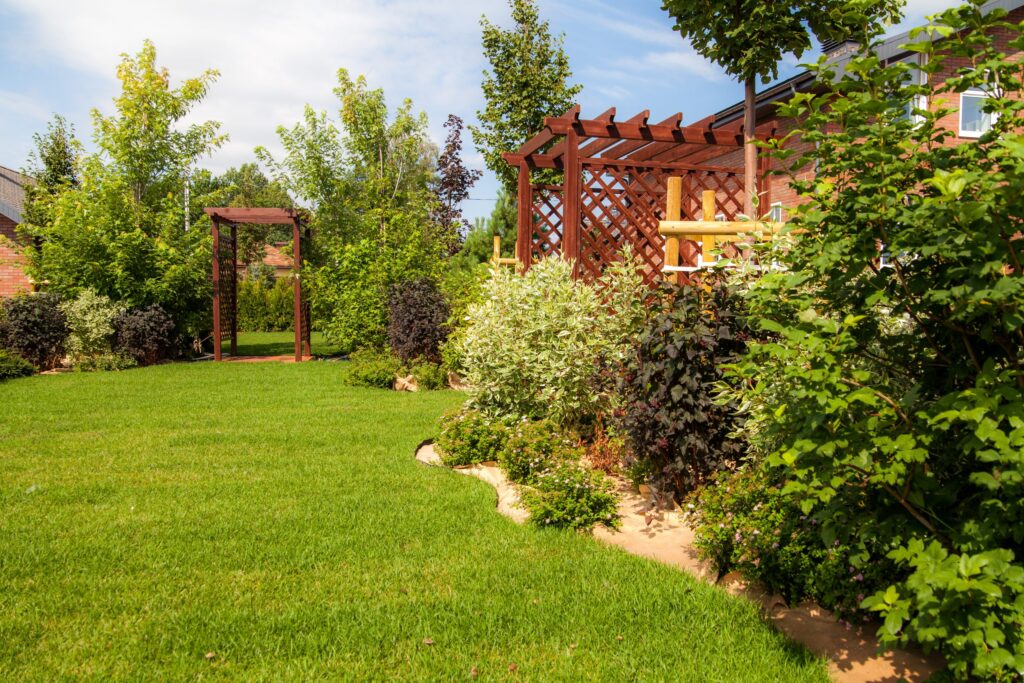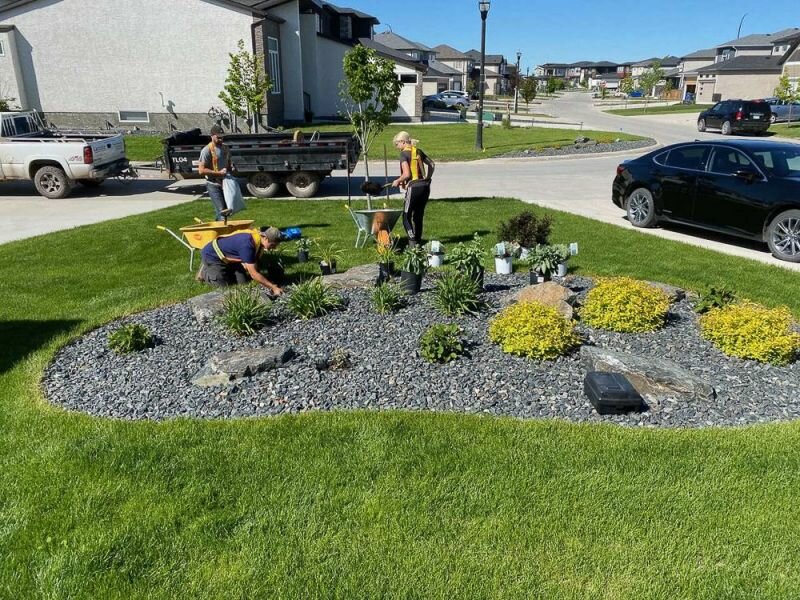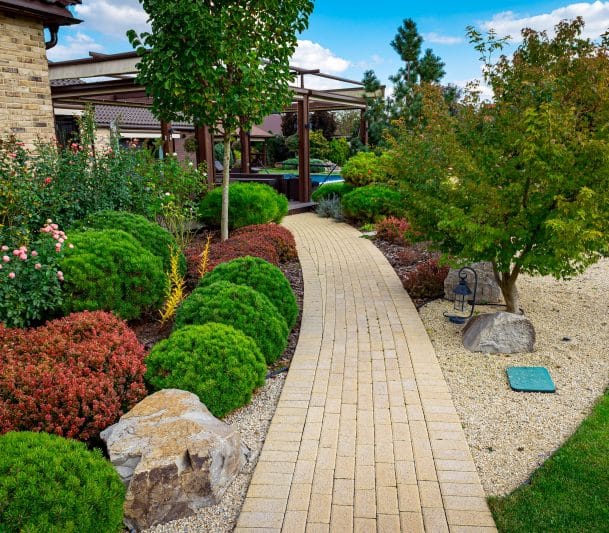Understanding the Comprehensive Range of Functions in Expert Landscaping Services
The substantial scope of professional landscaping services incorporates a range of essential elements - landscaping services. It consists of landscape design principles, plant option, and hardscaping features. Additionally, it attends to watering systems and maintenance methods. Each facet plays an essential duty in developing functional and visually pleasing outdoor areas. Comprehending just how these elements collaborate can expose much concerning the art and scientific research of landscaping. The trip into this detailed field is simply starting.
Landscape Design Principles
Reliable landscape design principles are important for producing unified outside areas that boost both aesthetic allure and performance (Learn More). These concepts assist the plan of components within the landscape, making sure a cohesive visual experience. Trick elements include balance, which disperses aesthetic weight equally; proportion, which connects the size of various components to each various other and the room; and unity, which creates a sense of integrity via constant styles and products

Plant Choice and Setup
In the domain name of professional landscape design, plant choice and installation play a critical role in accomplishing a flourishing garden. Emphasizing indigenous plant benefits, seasonal factors to consider, and the particular dirt and sunshine demands of each species guarantees a sustainable and aesthetically pleasing landscape. Cautious preparation in these locations not just boosts biodiversity however also advertises lasting ecological health.
Native Plant Benefits
Why should home owners consider native plants for their landscape design jobs? Native plants supply various advantages that boost both looks and environmental sustainability. They are well-adapted to local climates, calling for much less water and upkeep compared to non-native varieties. This strength lowers the need for chemical fertilizers and chemicals, promoting a much healthier community. Furthermore, indigenous plants provide habitat and food for regional wildlife, consisting of pollinators, which can increase biodiversity in residential areas. Their familiarity with local soil and climate condition also leads to far better growth rates and durability. By picking indigenous plants, home owners not just produce visually appealing landscapes however additionally add to ecological preservation, making a favorable effect on their neighborhood atmosphere. Subsequently, indigenous plants stand for a smart choice for landscape design tasks.
Seasonal Plant Considerations
Property owners that have actually welcomed indigenous plants in their landscape design can additionally boost their outdoor rooms by taking into consideration seasonal plant options. By integrating plants that flourish in certain periods, they can develop aesthetically enticing and dynamic landscapes throughout the year. Springtime may usher in lively blossoms like tulips and daffodils, while summer season can showcase rich vegetation and vibrant perennials. Fall presents a scheme of warm tones with asters and goldenrods, while winter season can be accentuated with evergreens and decorative lawns for appearance. Professional landscaping companies often suggest choosing plants that not just complement existing indigenous varieties yet also give year-round rate of interest and support neighborhood wild animals. This thoughtful technique to seasonal plant option guarantees a constantly progressing and sustainable yard setting.
Soil and Sunlight Demands
Successful landscape design hinges on comprehending the specific soil and sunlight demands of plants. Different varieties grow under differing conditions, needing a cautious analysis of both aspects during the selection process. Dirt types, such as sandy, clay, or loamy, influence drain, vitamins and mineral accessibility, and origin growth. Additionally, pH levels can affect plant health, requiring soil testing to ascertain suitability. Sunshine needs differ significantly; some plants flourish completely sunlight, while others choose full or partial color. An expert landscaper considers these aspects to assure peak development and aesthetic allure. By aligning plant choices with the atmosphere's details characteristics, landscapes can achieve sustainability, durability, and aesthetic consistency, ultimately resulting in successful plant establishment and long-term upkeep.
Hardscaping Attributes and Construction

While landscape design usually evokes photos of rich greenery and dynamic flowers, hardscaping attributes play a crucial role in defining exterior spaces. These elements, which include patios, walkways, keeping walls, and decorative stonework, supply framework and capability to yards and gardens. Hardscaping makes use of materials such as concrete, stone, block, and wood, permitting varied layouts that match the natural landscape.
The construction of hardscaping functions needs careful preparation and execution to guarantee resilience and aesthetic appeal. Experts evaluate site conditions, water drainage, and spatial connections to develop natural outdoor settings. Appropriate installation techniques are vital, as they stop concerns like erosion and shifting in time.
Integrating hardscaping not only enhances the aesthetic rate of interest of a residential property but likewise facilitates outside activities, making it a fundamental facet of detailed landscaping services. Inevitably, thoughtful hardscaping adds to both the capability and charm of exterior areas.
Irrigation Equipments and Water Management
Effective irrigation systems and water monitoring are crucial parts of professional landscape design, as they guarantee that plants obtain the necessary hydration for suitable development. These systems can differ from easy drip watering setups to sophisticated automated lawn sprinkler systems, designed to meet the details needs of diverse landscapes. Appropriate water management not only optimizes water usage, minimizing waste, however likewise enhances plant wellness and lessens illness risks.
Landscape design professionals evaluate numerous elements, consisting of soil kind, plant species, and neighborhood climate, to establish tailored watering options. In addition, incorporating rainwater harvesting strategies can even more boost sustainability and performance. Regular upkeep of watering systems is necessary to maintain performance and avoid leaks, which can lead to water loss and enhanced prices (Learn More). Eventually, a well-designed watering system plays a critical function in protecting the aesthetic charm of outdoor spaces while advertising eco-friendly stewardship within professional landscaping techniques
Lawn Care and Maintenance Methods
Yard care and upkeep techniques are fundamental for attaining a lavish, healthy and balanced yard that boosts the overall landscape. These strategies encompass various practices targeted at advertising ideal growth and visual allure. Routine mowing is essential, as it urges thick, also growth while preventing weeds from developing. Furthermore, proper fertilization gives required nutrients, with applications tailored to the specific turf kind and dirt conditions.
Watering practices should concentrate on deep, seldom irrigation to motivate origin advancement, while aeration improves dirt framework and promotes nutrient absorption. Parasite and illness monitoring is also vital; determining problems early permits effective treatments that decrease damages.
Overseeding can rejuvenate slim or broken yards, boosting thickness and shade (landscaping services). By carrying out these targeted yard treatment strategies, landscaping professionals can guarantee that backyards remain healthy and dynamic throughout the seasons, greatly contributing to the overall beauty of the residential or commercial property
Seasonal Landscape Care and Maintenance
As the seasons adjustment, appropriate landscape care comes to be important for maintaining the health and wellness and charm of outside spaces. Each season presents unique challenges and needs. In springtime, landscape professionals concentrate on trimming, growing, and fertilizing to urge development. Summer needs regular watering, weed control, and pest management to secure freshly developed plants.

Throughout the year, seasonal landscape maintenance warranties that outside areas stay healthy and aesthetically attractive. Expert services can provide customized maintenance plans that adapt to the specific requirements of each period, enabling building owners to enjoy dynamic landscapes year-round. In general, seasonal care is a crucial facet of expert landscape design that promotes longevity and aesthetic worth.

Lasting Landscaping Practices
An expanding number of homeowner are accepting lasting landscape design practices to produce eco friendly outdoor areas. These methods concentrate on saving resources, boosting biodiversity, and lessening environmental effect. Indigenous plants are typically selected for their low tide requirements and compatibility with neighborhood environments, reducing the need for chemical plant foods and pesticides. Rainfall gardens and permeable paving are employed to take care of stormwater overflow, promoting groundwater recharge and lowering disintegration.
Lasting landscaping includes natural horticulture techniques that focus on soil health and promote all-natural bug control. Effective watering systems, such as drip watering and rain harvesting, aid maximize water use. In addition, landscape developers significantly promote for using recycled products, such as recovered timber and stones, to decrease waste. By adopting these lasting methods, homeowner not just add to ecological preservation but likewise create cosmetically pleasing settings that can thrive with minimal maintenance.
Frequently Asked Questions
For how long Does a Landscape Design Job Commonly Take to Full?
Generally, a landscaping job can take anywhere from a few days to numerous weeks to finish, depending on the task's layout, dimension, and intricacy needs. Elements such as weather condition and resource schedule also influence timelines.
What Elements Impact the Expense of Landscaping Services?
Numerous variables influence landscape design solution expenses, including job dimension, design complexity, material high quality, labor expenditures, geographical area, and seasonal demand. Each component adds distinctively to the general economic requirements of a landscaping task.
Are Landscape Design Services Available Year-Round?
Landscaping services are usually available year-round, although availability may vary based on region, seasonal weather, and specific solution offerings. Some services may be restricted throughout severe climate or off-peak periods.
Do Landscape Design Companies Deal Service Warranties on Their Job?
Many landscaping firms do offer guarantees on their job, which can vary in length and protection. Customers are encouraged to ask regarding details terms, guaranteeing they recognize what is guaranteed and any type of problems that use.
Can I Design My Landscape Without Specialist Assist?
Yes, people can develop their landscapes without specialist help. They may do not have proficiency in plant option, format, and ecological considerations, possibly leading to less efficient styles that could require costly modifications later on.
In the domain name of expert landscape design, get more info plant option and installment play a vital function in achieving a growing garden. Homeowners who have accepted native plants in their landscape design can better improve their outdoor spaces by taking into consideration seasonal plant choices. Successful landscaping pivots on recognizing the details dirt and sunlight needs of plants. Reliable watering systems and water monitoring are crucial elements of specialist landscaping, as they ensure that plants obtain the necessary hydration for ideal growth. Landscape design professionals evaluate different aspects, including dirt type, plant types, and neighborhood environment, to develop customized watering options.